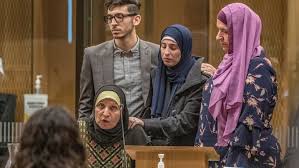Families confront New Zealand mosque shooter at sentencing

Families and survivors had their first chance to
confront the white supremacist who slaughtered 51 worshippers in a mass
shooting at two New Zealand mosques as his four-day sentencing hearing began
Monday.
“You killed your own humanity, and I don’t think the
world will forgive you for your horrible crime,” said a tearful Maysoon Salama,
the mother of 33-year-old Atta Elayyan, who was killed in March 2019 attacks.
“You thought you can break us. You failed miserably.”
The gunman, 29-year-old Australian Brenton Harrison
Tarrant, pleaded guilty in March to 51 counts of murder, 40 counts of attempted
murder and one count of terrorism — the first terrorism conviction in New
Zealand’s history. He could become the first person in New Zealand to be
sentenced to life imprisonment without the possibility of parole, the toughest
sentence available.
Tarrant was brought into the Christchurch High Court
shackled and wearing a gray prison outfit. In the dock, unshackled and
surrounded by five officers, he showed little emotion throughout the hearing.
He occasionally looked around the room, tapped his fingers, and watched the
survivors as they spoke.
The courtroom was only half full due to coronavirus
distancing requirements, while many others watched from adjacent courtrooms
where the hearing was streamed. Survivors and family members occasionally wept
and comforted each other.
Two dozen victims and family members told the court
about the pain of losing husbands, wives, sons and brothers. Some had family
members around them for support, others spoke through translators or on
pre-recorded videos from abroad.
One of those was grandmother Saira Patel, who spoke
from Melbourne in Australia and described the moment she thought she would die
in the Linwood mosque.
“I stretched both my arms toward my husband so we
would die together,” she said.
But it was her husband of 36 years, Musa, who was shot
in the back. When paramedics arrived, she said, they told her to push on the
bullet hole to lessen the bleeding, but her hands kept slipping with all the
blood. When they took over, she said, she held her husband’s warm hands until
they dropped. He had died.
“I’m still searching for my husband’s beautiful face
in the crowds, but he’s nowhere to be seen,” she said.
Some speakers raised their voices in anger when they
addressed the gunman. One said nothing less than the death penalty would be
fair. Janna Ezat, whose son Hussein Al-Umari was killed, looked at Tarrant and
spoke softly.
“I forgive you,” she said. “The damage is done,
Hussein will never be here. I only have one choice and that is to forgive.”
Monday’s hearing began with prosecutors outlining
the attacks in a 26-page summary of facts, the first detailed account by
authorities about what happened that day, including the revelation that Tarrant
had intended to burn down the mosques.
Crown prosecutor Barnaby Hawes said Tarrant moved to
New Zealand in 2017 and began buying an arsenal of high-powered weapons, as
well as 7,000 rounds of ammunition.
Two months before the attacks, Tarrant flew a drone
directly over the Al Noor mosque, recording an aerial view of the grounds and
buildings and taking note of the entry and exit doors, Hawes said.
Hawes said the gunman planned his attacks for when
the maximum number of worshippers were present, and that 190 people were in the
Al Noor mosque for Friday prayers on the day of the attacks.
In his car, the gunman had six guns — two AR-15
rifles, two other rifles, and two shotguns, the court heard. He also brought
with him four modified gas containers that he planned to use to burn down the
mosques after he finished shooting, Hawes said. The gunman later told police he
wished he had used them and that he wished he’d shot more people.
Hawes also detailed the bravery of Naeem Rashid, who
was killed at the Al Noor mosque.
“He ran at the defendant from the southeastern
corner of the room. When Mr. Rashid was approximately 1 meter from the
defendant, the defendant swung the AR-15 around and fired four shots at
point-blank range,” Hawes said.
“Mr. Rashid crashed into the defendant and the
defendant went down on one knee,” Hawes said, adding that Tarrant was able to
get back up and shoot Rashid again.
At the second mosque, Abdul Aziz chased Tarrant down
the driveway screaming at him, prosecutors said, and threw a discarded rifle at
his car, shattering a window. Aziz was not injured.
Tarrant has dismissed his lawyers and is
representing himself during the sentencing, raising fears he could try to use
the occasion as a platform to promote his racist views. He can choose to speak
once the survivors have spoken, although the judge will likely shut down any
attempts he makes to grandstand.
New Zealand abolished the death penalty for murder
in 1961, and the longest sentence imposed since then has been life imprisonment
with a minimum 30-year non-parole period. Justice Cameron Mander will decide on
the gunman’s sentence at the end of the hearing.
The attacks targeting people praying at the Al Noor
and Linwood mosques shocked New Zealand and prompted new laws banning the
deadliest types of semi-automatic weapons. They also prompted global changes to
social media protocols after the gunman livestreamed his attack on Facebook,
where it was viewed by hundreds of thousands of people.
Prosecutors said that after Tarrant left the Linwood
mosque he planned to drive to the town of Ashburton and attack a third mosque.
But he was rammed by two police officers, dragged out of his car and arrested.
Gamal Fouda, the imam of the Al Noor mosque who
survived the shooting, told the court that the gunman’s actions were misguided.
“We are a peaceful and loving community who did not
deserve your actions,” Fouda said. “Your hatred is unnecessary. If you have
done anything, you have brought the world community closer with your evil
actions.”






